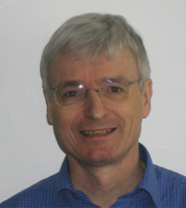
Michel Dufossé
1- French coordinator of an international cooperation with Czech Rep. (over 10 years) & Russia (>20 years).
2- involved in the preparation of European projects (the last one being DIOCLES, Y. Burnod coord., submitted to EC in 05/2007), and French national projects (last being FILTERADAPT, Y. Burnod coord., submitted to ANR in 03/2007).
3- recent articles (alphabetic order of authors' names for 1 st and 3 rd ) :
Bensmaïl S., Dufossé M., Ouezdou F.B. (2006) Learning control of humanoid robots through human computational principles. In: "Proc. IEEE/RSJ International Conf. Intelligent Robots and Systems (IROS)". Oct. 9-15, Beijing.
Frolov A.A., Dufossé M. (2005) How cerebral and cerebellar plasticities may cooperate during arm reaching movement learning : a neural network model. In: "Motor Control and Learning", M.L. Latash & F. Lestienne (Eds), Springer, pp 105-114.
Burnod Y., Combe P. Daval G., Dufossé M., Frankowska H., Kaladjian A. (2006) Enactive motor control by the embodied brain : a temptative model inspired from F. Varela. NeuroComp'06.
Research theme
A Varela-inspired approach implies that a brain model should not display an input-outut, nor a sensori-motor, nor a perception-action scheme. By contrast, the brain is embodied within a body delimited by its skin, eyes, ears... This embodiement let the brain to be an autopoietic system that enacts with its environment. The system must maintain or reach desired states, such as survival, pleasure ... despite any perturbations.
Learning processes of a goal-directed movement involves plasticities in various brain structures. In order to understand how these plasticities may cooperate, we developed a model of the cortico (cerebral cortex) - subcortical (cerebellar cortex and basal ganglia) plasticity interactions during arm movement learning.
Here, the embodied brain structures try to attain the dopaminergic-reinforced pleasure of maintaining, as long as possible, the unstable equilibrium of an inverted pendulum. This problem was chosen since it has already been addressed by many methods.
keywords: brain motor control, brain plasticity, motor learning, cerebellum, basal ganglia
Video and experimental material